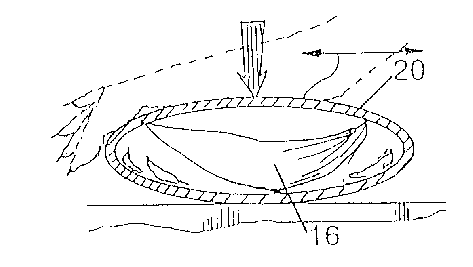Some of the information on this Web page has been provided by external sources. The Government of Canada is not responsible for the accuracy, reliability or currency of the information supplied by external sources. Users wishing to rely upon this information should consult directly with the source of the information. Content provided by external sources is not subject to official languages, privacy and accessibility requirements.
Any discrepancies in the text and image of the Claims and Abstract are due to differing posting times. Text of the Claims and Abstract are posted:
| (12) Patent: | (11) CA 2150975 |
|---|---|
| (54) English Title: | VEGETABLE PEELER |
| (54) French Title: | EPLUCHEUR DE LEGUMES |
| Status: | Expired and beyond the Period of Reversal |
| (51) International Patent Classification (IPC): |
|
|---|---|
| (72) Inventors : |
|
| (73) Owners : |
|
| (71) Applicants : |
|
| (74) Agent: | OSLER, HOSKIN & HARCOURT LLP |
| (74) Associate agent: | |
| (45) Issued: | 2000-04-04 |
| (22) Filed Date: | 1995-06-05 |
| (41) Open to Public Inspection: | 1995-12-07 |
| Examination requested: | 1997-06-02 |
| Availability of licence: | N/A |
| Dedicated to the Public: | N/A |
| (25) Language of filing: | English |
| Patent Cooperation Treaty (PCT): | No |
|---|
| (30) Application Priority Data: | ||||||
|---|---|---|---|---|---|---|
|
Disclosed are peelers for fruits and vegetables and the like food products. The peelers are tubular in shape and formed from an extruded flexible homogeneous composition. The tubuar shape and its flexibility enables the inside diameter food contacting surfaces to roll towards and away from one anohter while compressively engaging the food between the surfaces. Compressive rolling engagement of a food product between the food contacting surfaces results in peeling away of the food product outer layers.
Divulgués ci-présent sont des éplucheurs de fruits et légumes et autres produits alimentaires. Les éplucheurs sont de forme tubulaire et sont formés à partir d'une composition homogène souple extrudée. La forme tubulaire et sa souplesse permettent aux surfaces diamétrales intérieures au contact avec les produits alimentaires de rouler vers et de s'écarter les unes des autres tout en engageant la nourriture entre les surfaces par compression. L'engagement roulant par compression d'un produit alimentaire entre les surfaces au contact avec les produits alimentaires se traduit par l'épluchage des couches externes du produit alimentaire.
Note: Claims are shown in the official language in which they were submitted.
Note: Descriptions are shown in the official language in which they were submitted.

2024-08-01:As part of the Next Generation Patents (NGP) transition, the Canadian Patents Database (CPD) now contains a more detailed Event History, which replicates the Event Log of our new back-office solution.
Please note that "Inactive:" events refers to events no longer in use in our new back-office solution.
For a clearer understanding of the status of the application/patent presented on this page, the site Disclaimer , as well as the definitions for Patent , Event History , Maintenance Fee and Payment History should be consulted.
| Description | Date |
|---|---|
| Time Limit for Reversal Expired | 2015-06-05 |
| Letter Sent | 2014-06-05 |
| Maintenance Request Received | 2013-03-08 |
| Inactive: IPC from MCD | 2006-03-11 |
| Letter Sent | 2002-12-02 |
| Inactive: Single transfer | 2002-10-16 |
| Grant by Issuance | 2000-04-04 |
| Inactive: Cover page published | 2000-04-03 |
| Inactive: Entity size changed | 2000-02-17 |
| Inactive: Final fee received | 2000-02-09 |
| Inactive: Applicant deleted | 2000-01-27 |
| Pre-grant | 2000-01-11 |
| Inactive: Final fee received | 2000-01-11 |
| Notice of Allowance is Issued | 1999-08-13 |
| Letter Sent | 1999-08-13 |
| Notice of Allowance is Issued | 1999-08-13 |
| Inactive: Approved for allowance (AFA) | 1999-07-28 |
| Amendment Received - Voluntary Amendment | 1999-07-16 |
| Letter Sent | 1999-07-12 |
| Inactive: Single transfer | 1999-06-08 |
| Inactive: S.30(2) Rules - Examiner requisition | 1999-05-27 |
| Inactive: S.30(2) Rules - Examiner requisition | 1999-05-27 |
| Inactive: Office letter | 1999-04-26 |
| Inactive: Adhoc Request Documented | 1999-04-26 |
| Inactive: Correspondence - Prosecution | 1999-03-31 |
| Inactive: Adhoc Request Documented | 1999-03-29 |
| Inactive: S.30(2) Rules - Examiner requisition | 1998-11-27 |
| Amendment Received - Voluntary Amendment | 1998-08-12 |
| Letter sent | 1998-05-25 |
| Advanced Examination Determined Compliant - paragraph 84(1)(a) of the Patent Rules | 1998-05-25 |
| Inactive: Advanced examination (SO) | 1998-05-13 |
| Amendment Received - Voluntary Amendment | 1998-05-13 |
| Inactive: Advanced examination (SO) fee processed | 1998-05-13 |
| Letter Sent | 1997-08-25 |
| Inactive: Status info is complete as of Log entry date | 1997-08-22 |
| Inactive: Application prosecuted on TS as of Log entry date | 1997-08-22 |
| All Requirements for Examination Determined Compliant | 1997-06-02 |
| Request for Examination Requirements Determined Compliant | 1997-06-02 |
| Application Published (Open to Public Inspection) | 1995-12-07 |
There is no abandonment history.
The last payment was received on 1999-05-31
Note : If the full payment has not been received on or before the date indicated, a further fee may be required which may be one of the following
Patent fees are adjusted on the 1st of January every year. The amounts above are the current amounts if received by December 31 of the current year.
Please refer to the CIPO
Patent Fees
web page to see all current fee amounts.
Note: Records showing the ownership history in alphabetical order.
| Current Owners on Record |
|---|
| ZAK DESIGNS, INC. |
| Past Owners on Record |
|---|
| BENJAMIN OMESSI |